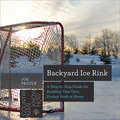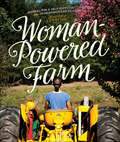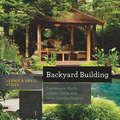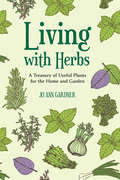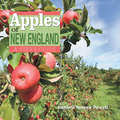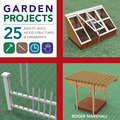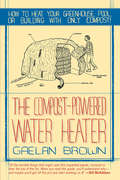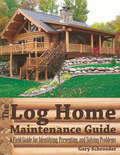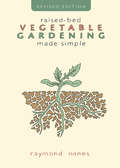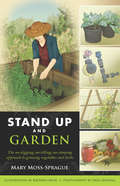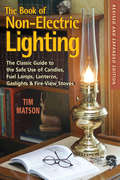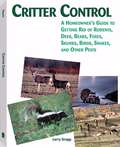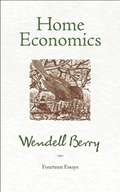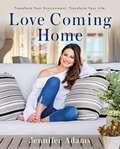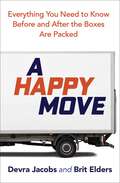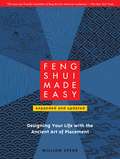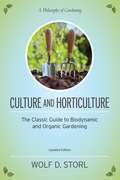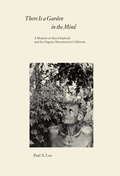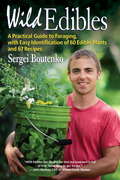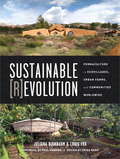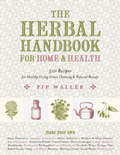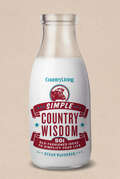- Table View
- List View
The Typewriter Revolution: A Typist's Companion for the 21st Century
by Richard PoltThe connoisseur's guide to the typewriter, entertaining and practical What do thousands of kids, makers, poets, artists, steampunks, hipsters, activists, and musicians have in common? They love typewriters—the magical, mechanical contraptions that are enjoying a surprising second life in the 21st century, striking a blow for self-reliance, privacy, and coherence against dependency, surveillance, and disintegration. The Typewriter Revolution documents the movement and provides practical advice on how to choose a typewriter, how to care for it, and what to do with it—from National Novel Writing Month to letter-writing socials, from type-ins to typewritten blogs, from custom-painted typewriters to typewriter tattoos. It celebrates the unique quality of everything typewriter, fully-illustrated with vintage photographs, postcards, manuals, and more.
Backyard Ice Rink: A Step-by-Step Guide for Building Your Own Hockey Rink at Home (Countryman Know How)
by Joe ProulxSimple, easy-to-follow instructions for building a compact (and removable) skating rink in your own backyard Driven in large part by the popularity of the NHL's Winter Classic, outdoor hockey is enjoying an unprecedented revival. For a sport that began under the open sky, a backyard rink allows for a return to the origins of the game and can provide a memorable neighborhood gathering place and a place for players to train without the expense of indoor ice rental. In Backyard Ice Rink, blogger and professional rink builder Joe Proulx guides you through every step of building your own backyard ice skating rink. From the simplest wooden frame to elaborate tall-board rinks, from measuring the slope in your yard to constructing your frame using parts found at your local hardware store, Proulx makes the project easy to tackle. In addition to the four easy-to-follow photo-intensive rink plans, Proulx also covers ice maintenance, building your own bench and goals, teardown, and storage through the summer months.
Woman-Powered Farm: Manual for a Self-Sufficient Lifestyle from Homestead to Field
by Michael Levatino Audrey LevatinoTo go-to guide for women who want to be part of the farming revolution. Women are leading the new farming revolution in America. Much of the impetus to move back to the land, raise our own food, and connect with our agricultural past is being driven by women. They raise sheep for wool, harvest honey from their beehives, grow food for their families and sell their goods at farmers' markets. What does a woman who wants to work the land need to do to follow her dream? First, she needs this book. It may seem strange to suggest that women farmers need a different guide than male farmers, but women often have different strengths and goals, and different ways of achieving those goals. Audrey Levatino shares her experiences of running a farm and offers invaluable advice on how to get started, whether you have hundreds of acres or a simple lot for an urban community garden. Filled with personal anecdotes and stories from other women farmers, from old hands to brand new ones, from agricultural icons like Temple Grandin, to her own sister, this book is a reassuring and inspirational guide that discusses: Should you do an internship or jump right in? How to find a farm or how to handle one that you've inherited Best practices for selling at the farmer's market and how to sell your goods locally Farmhouse chores and how to get them done right How to handle large power tools, including a chainsaw Planning and growing an organic farm garden Incorporating animals as part of a farm ecosystem Where to get started if you want to farm-school your kids Tips for keeping your mind, body and spirit healthy while undertaking the demanding nature of farm work It's all here, in the same warm and friendly voice that readers embraced in The Joy of Hobby Farming. Full-color photography throughout provides step-by-step instructions for anything you'll need to do on your farm.
Backyard Building: Treehouses, Sheds, Arbors, Gates, and Other Garden Projects (Know How)
by Jean Stiles David StilesHere is the very best of backyard building: Popular building authors Jeanie and David Stiles--whose treehouse once garnered a spread in Architectural Digest--have gathered dozens of original plans for treehouses, playhouses, and sheds, as well as a summer house, tea house, garden arbor, and functional workroom. Backyard Building will cover backyard accessories, the fundamentals of tools and materials, and useful tips based on real-life questions from the couple's popular website. Its unique style, with hand-drawn illustrations to guide the reader through the building process in a user-friendly way, stands out from the crowd. The clear, detailed drawings are not only easy to follow but a pleasure to look at; they are supplemented by irresistible color photographs.
Living with Herbs: A Treasury of Useful Plants for the Home and Garden (Second Edition)
by Jo Ann GardnerWith vivid stories and an infectious delight in the garden, Jo Ann Gardner shares her wisdom and useful tips on planting, growing, and harvesting more than 90 different kinds of herbs. Every gardener will benefit from the author's intimate knowledge of herbs and their histories, growing needs, and uses in the kitchen and home. The wisdom she shares--with vivid stories, a self-deprecating wit, and an infectious delight in the garden--will be useful to herb growers living anywhere in the United States or Canada. Included in this practical guide is instruction on: * Planting, caring for, and propagating herbs indoors, outdoors, and in containers * Harvesting, drying, and preserving herbs, flowers, and seeds * Two dozen ways to use herbs in the home, from aromatherapy and infusions to vinegars and wreaths * Landscaping with herbs, with plans for a harvest bed, rose garden, and other themed gardens * The growing needs and unique uses of more than 90 herbs, along with favorite recipes "Readers from all regions will benefit from these simple strategies for dealing with common problems." --Booklist
Apples of New England: A User's Guide
by Russell PowellA guide to more than 200 varieties of apples! This fascinating and helpful guide will offer practical advice about rare heirlooms and newly discovered varieties, chapters on the rich tradition of apple growing in New England and on the "fathers" of American apples--Massachusetts natives John Chapman ("Johnny Appleseed") and Henry David Thoreau. Apples of New England will present the apple in all its splendor: as biological wonder, super food, work of art, and cultural icon. Apples of New England will be an indispensable resource for anyone identifying apples in New England orchards, farm stands, grocery stores--or their own backyard. Photographs of the more than 200 apples discovered, grown, or sold in New England will be accompanied by notes about flavor and texture, history, ripening time, storage quality, and best use.
Garden Projects: 25 Easy-to-Build Wood Structures & Ornaments
by Roger MarshallGarden Projects gives you a range of plans for useful and ornamental additions to your garden. Each project is fully explained, with detailed step-by-step descriptions and illustrations to guide you through. Garden Projects suit your needs and abilities, from practical and simple raised garden beds to more ambitious things, like a tool shed. There are more whimsical structures too--a flagpole, a garden swing, and an ornamental wheelbarrow for flower arrangements among them. Author Roger Marshall has carefully designed projects that don't require a vast array of tools or advanced woodworking skills. Every gardener will find ideas and plans to enhance his or her garden in this helpful book. Marshall applies his know-how and skillful delivery to a wide range of building projects that might take a weekend afternoon or provide a way to pass the time constructively on those dark winter days when you can't wait to get back out into the garden.
The Compost-Powered Water Heater: How to heat your greenhouse, pool, or buildings with only compost!
by Gaelan BrownHere is a revolutionary approach for heating rooms and generating hot water. Author Gaelan Brown has worked with engineers and compost scientists to refine methods of composting that can heat greenhouses, barns, buildings, and hot water, all without combustion. It seems almost too good to be true: make high-value organic compost while generating reliable combustion-free heat. But it works, and this book is your practical introduction. With detailed case studies of large scale engineered systems and plans for constructing small DIY systems, you'll find step-by-step illustrations and photos to guide you through the process. A review of calculations to help you estimate the heating capabilities of various approaches and other planning tools make this book invaluable for compost heat recovery on any scale.
The Log Home Maintenance Guide: A Field Guide for Identifying, Preventing, and Solving Problems
by Gary SchroederPreventing problems and dealing with them when they occur. America has hundreds of thousands of log homes, and every one of them presents unique maintenance issues that differ from homes of traditional stick-frame construction. Lack of knowledge about the unique characteristics of a log home all too often results in owners inadvertently doing damage when they try to make repairs. Owners of log homes have long relied on the expertise of log home builder and specialist Gary Schroeder and his Schroeder Log Home Supply company, a trusted source of information and guidance. From dry rot to carpenter ants, Schroeder has seen it all. Now he shares his wisdom on how to preserve and protect your beautiful log home. This newly revised edition takes advantage of all the recent techniques and products--it's a state-of-the-art guide to identifying, diagnosing, and solving problems so you'll enjoy many trouble-free years in your log home. Gary Schroeder, a former forester and consultant, has also been a custom log home builder and restoration contractor. He and his wife, Kathy, started Schroeder Log Home Supply, Inc., now a leader in the field, in 1986.
Raised-Bed Vegetable Gardening Made Simple
by Raymond NonesGrow more veggies--in less space and with less work--than you ever thought possible!Having a backyard garden in a small space got a lot easier when the first edition of this wonderful handbook was published. Now it gets even easier--Raised-Bed Vegetable Gardening Made Simple has been revised! Framed raised beds and a modular approach to growing vegetables means more production in less space and with less work. Whether you live in a small city apartment or on a large country estate, you'll find something in this book to help with your specific gardening challenges. Nones shows you how to set everything up and then gives you in-depth descriptions of all the procedures needed to achieve gardening success: sowing seeds, thinning, transplanting, cultivating, mulching, watering, harvesting, pest control, composting, crop rotation, and seed saving. It's a complete gardening guide for both the beginner and the experienced gardener, useful for those who have never tried raised beds before as well as for those who have already tried a raised-bed system. Far less bending, far less weeding, more produce at harvest time--gardeners, what have you been waiting for? Raymond Nones is a dirt-under-the-fingernails organic practitioner and proud penny-pincher who lives and gardens in Queens, New York.
Earth Ponds: The Country Pond Maker's Guide to Building, Maintenance, and Restoration (Third Edition)
by Tim MatsonThe bible of pond-making in a fully redesigned 30th-anniversary edition. There is nothing like a pond. What else can simultaneously increase your aesthetic pleasure, offer recreational opportunities, help the environment, and increase the value of your property? Earth Ponds is the standard resource for building and maintaining these important and lovely landscape features. For thirty years now Earth Ponds, with some 100,000 copies in print, has guided an entire generation of pond makers on everything from site planning to soil sampling to drainage and wildlife management. It’s a complete overview of the country pond. Illustrations guide the pond builder through every step of the process; chapters carefully describe the issues and decisions in a wonderfully personal way. It’s the condensed wisdom of a man who has spent a lifetime building, restoring, and maintaining ponds.
Stand Up and Garden: The no-digging, no-tilling, no-stooping approach to growing vegetables and herbs
by Greg Aspinall Kathren Moss Mary Moss-SpragueFocusing on containers, trellises, and raised beds, this book shows how everyone can garden, including those with physical limitations like arthritis or location limitations like apartment-dwellers without backyards. Knowing where our food comes from is a huge issue; food safety and costs seem to figure more prominently in our lives all the time. Many people would like to grow their own vegetables but don’t know how to begin—digging, plowing, planting, weeding, and watering a large plot can be daunting. Stand Up and Garden shows how everyone can garden, including those with physical limitations like arthritis or location limitations like apartment-dwellers without backyards. Imagine harvesting radishes, carrots, and strawberries in the spring; herbs, tomatoes, and cucumbers all through the summer; beets, spinach, and even potatoes in autumn. By focusing on containers, trellises, and raised beds, Master Gardener Mary Moss-Sprague has improved upon traditional gardening by developing ways to grow plants that produce large amounts of food—enough for canning and other preservation—in small vertical spaces. New gardeners will find basic planting and growing information for a wide range of vegetables and herbs. Experienced growers will find economical, space- and energy-saving ideas. In addition to vertical gardening techniques, there are tips on overwintering plants and details on sustainable and eco-friendly gardening practices. Step-by-step illustrations and supply lists of inexpensive materials make projects like building a trellis or constructing a raised bed using straw bales accessible to everyone, regardless of ability or skill. There’s even a chapter on installing a micro-drip irrigation system—a very helpful innovation that eliminates the need for heavy hand-held watering devices. Use this great reference for inspiration and instruction on sustainable and economical gardening practices and techniques.
The Book of Non-electric Lighting: The Classic Guide to the Safe Use of Candles, Fuel Lamps, Lanterns, Gaslights & Fire-View Stoves
by Tim MatsonTim Matson surveys an often overlooked aspect of independent living—firelight. In this completely revised and updated classic, Matson describes in lively detail all the elements of firelight—beginning with an explanation of the lighting system he developed from his Vermont home. • The romantic history and modern molding of candlepower • Traditional kerosene lamps • The versatile Aladdin • Liquid propane (LP) gas lights • Kerosene and gas pressure lanterns (the Coleman) • Incandescent mantle safety • The "Return of Firelight" from glass-fronted hearths and stoves In addition, Matson shows how to select, assemble, install, and safely maintain these non-electric sources of light. This guide will be indispensable for vacation homes, camps, boats, RVs, independent homesteads—and anywhere in a blackout.
Critter Control: A Homeowner's Guide to Getting Rid of Rodents, Deer, Bears, Foxes, Skunks, Birds, Snakes, and Other Pests
by Larry GruppThe sprawl of suburbia, destruction of wildlife areas, overregulation of game animals, and reduced popularity of hunting and fishing have resulted in more and more people coming into direct contact with wild animals on a regular basis. In this invaluable do-it-yourself guide, veteran outdoorsman Larry Grupp gives readers a comprehensive "toolbox" of specific devices and strategies to deal safely, legally and effectively with more than 30 common North American pests, including deer, bears, raccoons, rabbits, beavers, porcupines, skunks, foxes, coyotes, rats, squirrels, bats, birds, fish and reptiles. Understanding these critters and how to best control them is the basis of this information-packed manual. You will learn when to be cautious, when to be accommodating and when and how to take direct action if the animals must be eradicated. The primary tools for dealing with unwanted creatures are fences, repellants, fumigators and traps. Grupp examines each solution and tells the reader how to most effectively and economically use them. He also provides a helpful table for using specific baits and lures to trap various varmints. City and country dwellers alike will find the answers they need to rid their homes and properties of destructive wildlife once and for all.
Home Economics: Fourteen Essays
by Wendell Berry"My work has been motivated," Wendell Berry has written, "by a desire to make myself responsibly at home in this world and in my native and chosen place." In "Home Economics," Mr. Berry explores this process and continues to discuss what it means to make oneself "responsibly at home." His title reminds us that the very root of economics is stewardship, household management. To paraphrase Confucius, a healthy planet is made up of healthy nations that are simply healthy communities sharing common ground, and communities are gatherings of households. A measure of the health of the planet is economics--the health of its households. Any process of destruction or healing must begin at home. Mr. Berry speaks of the necessary coherence of the "Great Economy," as he argues for clarity in our lives, our conceptions, and our communications. To live is not to pass time, but to spend time. Whether as critic or as champion, Wendell Berry offers careful insights into our personal and national situation in a prose that is ringing and clear.
Love Coming Home: Transform Your Environment. Transform Your Life
by Jennifer AdamsLove Coming Home is a guide for readers to envision the home of their dreams and manifest them where they live right now no matter what their budget or living situation.Home is your base. Home is your sanctuary. It&’s where your best life begins. This friendly guide will give you the tools and knowledge, and empower you to make wherever you live—be it rented, owned, or shared—a place where you will absolutely love coming home to. No matter how much or how little someone has at a given moment, we often hold the belief that our actual dream home will be a place we will eventually move to down the road once we&’ve saved enough and worked hard enough to achieve it. We are all striving to discover that perfect place and rarely see the potential in the place we are living in right now. Jennifer Adams, designer and founder of the international home décor company Home by Jennifer Adams®, shares her insider secrets of how you don&’t have to wait. In Love Coming Home, Jennifer combines her professional designer&’s tool kit of proven tips and resources with her inspirational coaching experience, motivating and empowering you to turn your ideas of a dream home into reality by: demystifying the practical and powerful visualization tool, Vision Boards showing you simple steps to define, refine, and align your home projects and ideas into manageable goals inspiring you to let go of restrictions and take action with confidence sharing her top eleven designer&’s secrets, and so much more Jennifer&’s step-by-step, room-by-room, guidance will help you create a welcoming and functioning space that expresses your unique individuality throughout even the smallest to largest of floor plans. Your dwelling can become an environment that supports and inspires you, to be your perfect sanctuary, because home is where your best life begins!
A Happy Move: Everything You Need to Know Before and After the Boxes Are Packed
by Devra Jacobs Brit EldersThis interactive how-to book can help relieve the anxiety and stress of relocation while giving people who are moving great tips on how to organize, control, and enjoy the experience.Moving. It&’s a major life change. It doesn&’t matter if it&’s across town or across the country, the event of moving creates a mixed emotional mindset. From packing up all your possessions to renting and driving a moving truck to reconnecting your services, there are so many things to take care of in a move that the whole process can be daunting. Sprinkled with first-hand experiences and tips, A Happy Move is your owner&’s guide for a seamless, practical, stress-free move. This book provides plenty of recommendations and resources, with inside knowledge from U-Haul® and 1-800-PACK-RAT. The convenient spiral-bound book includes various lists that help you check off the items required before, during, and after a move to make the process easier, more cost-effective, and more fulfilling. It&’s a tool for anyone considering a location change, whether it&’s for work, school, military service, closeness to family and friends, or just a change of scenery. No matter the distance or final destination, if you&’re a renter or homeowner, you, too, can follow this step-by-step process and experience A Happy Move.
Feng Shui Made Easy, Revised Edition: Designing Your Life with the Ancient Art of Placement
by William SpearThe first edition, released in 1995, was lauded by seasoned practitioners and beginners alike. And no wonder. While most of the early English-language books on feng shui were dauntingly mystical or relied on complex calculations or culturally specific design practices, Feng Shui Made Easy took a more holistic approach, clearly explaining the fundamentals while guiding readers on an inner journey of understanding.Thoughtfully written and beautifully illustrated, the book is structured around an "architecture of consciousness" that is really the inner landscape. The book explores each "house" of the bagua--the chart representing one's journey through life; relationships with parents, loved ones, and community; creativity; spirituality; and connectedness to the source of life--and the symbolism of the corresponding I Ching trigram. Feng Shui Made Easy helps readers discover the nature of these connections, as well as learn what obstructions must be removed to change fixed patterns of behavior and restore balance, harmony, and inner peace--a process that, when combined with external adjustments, results in increased success and lasting change in all areas of life.This revised edition expands on the author's intuitive approach with new sections on health, children's environments, and ecological concerns and sustainable practices. The author also corrects misconceptions about feng shui and uses fascinating case studies to share valuable insights he gained from interactions with his clients and readers.From the Trade Paperback edition.
Culture and Horticulture: The Classic Guide to Biodynamic and Organic Gardening
by Wolf D. Storl Larry BergerVarious studies have shown time and again that small organic farms and home gardens are capable of producing more food per acre with less fossil energy than large-scale commercial agricultural installations dependent on machines and toxic chemical fertilizers and pesticides. This classic book by Wolf D. Storl, a respected elder in the practice of permaculture, details how food is grown holistically and beautifully by traditional communities around the world, and shows how to apply their ancient wisdom to our own gardens.With interest in natural, sustainable, organic and local food at an all-time high, people are looking beyond their farmers markets and CSA cooperatives to hyperlocal ways of growing healthy, delicious produce in urban gardens and their own backyards. Culture and Horticulture details time-tested methods that are as effective today as they were hundreds of years ago. On the practical front, the book works as a manual for creating and maintaining a bountiful harvest. It explains how to build the soil to maintain fertility; how to produce compost; how to plant, sow, and tend the various fruit and vegetable plants; how to rotate crops and practice companion planting; how to set up a favorable microclimate; how to deal with so-called weeds and pests; how to harvest at the right time; and finally how to store vegetables and herbs. Special emphasis is given to the art and science of composting, the compost being the "heart" of any self-sufficient garden and a model for the cycle of life, death, and rebirth.At the same time the reader is introduced to the wider aspects of horticulture, to its historical, philosophical, and cosmological contexts and social relevance. Gardening is a cultural activity, shaped by peoples' thoughts, wishes, and needs as well as by their cultural traditions. The author, an anthropologist by profession who has investigated the gardening practices of indigenous people throughout the world and worked for many years on biodynamic farms and in his own food garden, will introduce the reader to Rudolf Steiner's vision of the garden as an organic unit, embedded in the context of terrestrial and cosmic forces. Storl explains the importance of cosmic rhythms (solar, lunar, and planetary), the role of biodynamic herbal preparations as "medicines" for the garden organism, and the so-called "etheric" and "astral" forces. The book presents a vision of the garden as seen through the eyes of "Goethean science," a magical place where alchemical transformations of material substances take place.
There Is a Garden in the Mind
by Paul A. LeeThere Is a Garden in the Mind presents an engaging look at the work and life of pioneering organic gardener Alan Chadwick and his profound influence on the organic farming movement. In this wide-ranging and philosophical memoir, author Paul Lee recounts his first serendipitous meeting with Chadwick in Santa Cruz, California, in 1967, and their subsequent founding of the Chadwick Garden at UC Santa Cruz, the first organic and biointensive garden at a U.S. university. Today, there are few who would dispute the ecological and health benefits of organically produced food, and the student garden project founded by Chadwick and Lee has evolved into a world-renowned research center that helps third-world farmers obtain high yields using organic gardening. But when Chadwick and Lee first broke ground in the 1960s, the term "organic" belonged to the university's chemists, and the Chadwick Garden spurred a heated battle against the whole system of industrial existence. Lee's memoir contextualizes this struggle by examining the centuries-old history of the conflict between industrial science and organic nature, the roots of the modern environmental movement and the slow food movement, and the origin of the term "organic." His account of Chadwick's work fills in a gap in the history of the sustainable agriculture movement and proposes that Chadwick's groundwork continues to bear fruit in today's burgeoning urban garden, locavore, and self-sufficiency movements.Table of contents:Chapter one The English Gardener ArrivesChapter two The English Gardener Goes to WorkChapter three The Garden PlotChapter four Goethe the Vitalist contra Newton the PhysicalistChapter five Urea! I Found It!Chapter six USA and Earth DayChapter seven The MethodChapter eight Chadwick DepartsChapter nine A Moral Equivalent of WarChapter ten The Death of ChadwickChapter eleven California Cuisine and the Homeless Garden ProjectChapter twelve A Biodynamic Garden on Long IslandChapter thirteen Chadwick's LegacyFrom the Trade Paperback edition.cy
Wild Edibles
by Sergei BoutenkoIn this field guide to foraging wild edible plants, Sergei Boutenko (son of raw-food guru Victoria Boutenko) explores the health benefits of wild-harvested food, explains how to safely identify trailside weeds, herbs, fruits, and greens that grow worldwide, and shares his delicious, nutrient-dense recipes.Sergei Boutenko has been gathering wild plants since he was 13, when, early on in a 6-month hike from Mexico to Canada, he and his raw-food family ran out of provisions and turned to foraging for survival in the wild. Back in civilization, Boutenko was dismayed by the inferior quality of store-bought food and industrial agriculture, and began to regularly collect wild plants near his home and on his travels. Now, in Wild Edibles, he shares knowledge gleaned from years of live-food wildcrafting and thriving in harmony with nature.This practical guide to plant foraging gives hikers, backpackers, raw foodists, gardeners, chefs, foodies, DIYers, survivalists, and off-the-grid enthusiasts the tools to identify, harvest, and prepare wild edible plants. The book outlines basic rules for safe wild-food foraging and discusses poisonous plants, plant identification protocol, gathering etiquette, and conservation.Boutenko explores in detail the many rewards of eating wild flora: environmental protection, sustainability, saving money, economic self-sufficiency, and healthy living. He draws on thoroughly researched nutrition science to make a compelling case for the health benefits of a diverse, local-food diet that includes wild greens.The majority of the 60 edible plants described in this field guide can be found worldwide, including common-growing trees. Over 300 color photos make plant identification easy and safe. A chapter containing 67 high-nutrient vegan recipes--including green smoothies, salads and salad dressings, spreads and crackers, main courses, juices, and sweets--provides inspiration to join Sergei on the trail to radiant health."Wild Edibles: A Practical Guide to Foraging, with Easy Identification of 60 Edible Plants and 67 Recipes has taught me that my backyard is full of free food! Way to go, Sergei." --John Mackey, CEO of Whole Foods MarketFrom the Trade Paperback edition.
Sustainable Revolution
by Paul Hawken Louis Fox Juliana Birnbaum Erika RandUrban gardeners. Native seed-saving collectives. Ecovillage developments. What is the connection between these seemingly disparate groups? The ecological design system of permaculture is the common thread that weaves them into a powerful, potentially revolutionary--or reevolutionary--movement. Permaculture is a philosophy based on common ethics of sustainable cultures throughout history that have designed settlements according to nature's patterns and lived within its bounds. As a movement that has been building momentum for the past 40 years, it now is taking form as a growing network of sites developed with the intention of regenerating local ecologies and economies. Permaculture strategies can be used by individuals, groups, or nations to address basic human needs such as food, water, energy, and housing. As a species, humans are being called forth to evolve, using our collective intelligence to meet the challenges of the future. Yet if we are to survive our collective planetary crisis, we need to revisit history, integrating successful systems from sustainable cultures. To boldly confront our position on the brink of the earth's carrying capacity and make changes that incorporate the wisdom of the past is truly revolutionary. Sustainable Revolution features the work of a worldwide network of visionaries, including journalists, activists, indigenous leaders and permaculturists such as David Holmgren, Vandana Shiva, Charles Eisenstein, Starhawk, Erik Assadourian, Victoria Tauli-Corpuz, Albert Bates, and Geoff Lawton. This beautifully photographed collection of profiles, interviews, and essays features 60 innovative community-based projects in diverse climates across the planet. Edited by anthropologist Juliana Birnbaum Fox and award-winning activist filmmaker Louis Fox, it can be read as an informal ethnography of an international culture that is modeling solutions on the cutting edge of social and environmental change. The research presented in the book frames the permaculture movement as a significant ally to marginalized groups, such as the urban poor and native communities resisting the pressures of globalization. Sustainable Revolution uplifts and inspires with its amazing array of dynamic activists and thriving, vibrant communities.From the Trade Paperback edition.
The Herbal Handbook for Home and Health
by Pip WallerKitchen pharmacy meets green cleaning and natural beauty in this comprehensive handbook of 501 recipes that harness the power of plants to enhance wellness and toxin-free living. Expert herbalist Pip Waller provides a wealth of information about growing, collecting, preserving, and preparing herbs for a variety of purposes--from cleaning products, to food and drink, medicines, beauty products, and more. Attractive and easy to use, The Herbal Handbook for Home and Health includes growing tips and profiles of herbs, guidelines for setting up an herbalist's kitchen, and techniques to make everything from tinctures to tonics. A valuable resource for anyone affected by allergies or sensitivities, this compendium is handsomely produced with two-color printing throughout and more than three hundred striking illustrations.The Handbook includes contributions from herbalists from around the world and encompasses recipes that range from very simple to more complex. Seasoned herbalists as well as those just beginning to explore the world of herbs will find something to start their own nontoxic, non-allergenic domestic revolution.The book includes: * A history of herbal lore * The herbalist's kitchen--equipment and procedures for harnessing the power of plants * Green cleaning products (from floor wax to stain removers) * Herbal pharmacy (from throat lozenges to hangover cures) * Nutritional supplements and detoxes * First aid (from anti-anxiety drops to bruise ointment) * For travel (insect repellant to anti-nausea drops) * Food and drink (breads, butters, wines, teas) * Beauty and balms (toothpaste to shampoo to lip balm) * Kitchen Pharmacy * Food & Drink * Beauty, Balms & Personal Care
Following Christ: Activity Grade 6 (Faith & Life)
by IgnatiusThird Edition The activity book is designed for use in the home or classroom and provides creative activities for review and reinforcement of each lesson. Through carefully developed and selected activities, the emphasis is on understanding and putting into practice the teachings of Christ in everyday life. The blueprint for a life of the law of God, especially in the Ten Commandments, and the presence of Jesus in the Holy Mass. The interaction of the challenges of God's law and his gifts of grace that help us fulfill his law. Part 1: The Ten Commandments. Forming the conscience and increasing closeness to God. Part 2: The Holy Mass. An emphasis on the Real Presence and Christ's sacrifice and explanation of the parts of the Mass. Part 3: The Last Things. Death and God's judgment of us, with an emphasis on the great happiness of Heaven. To help the sixth grade student learn to love the law as Christ did and to cherish and love the Mass as our best prayer to God, and especially to revere and adore Jesus in the Blessed Sacrament.
Country Living Simple Country Wisdom: 501 Old-Fashioned Ideas to Simplify Your Life
by Susan WaggonerHas life become a bundle of stress and mess? Top-selling author Susan Waggoner has the solution. This ingenious, fun-to-read illustrated guide--newly in paperback--offers tried-and-true household hints and practical solutions to everyday problems, from the &“A-to-Z Guide to Food&” to &“The Tao of Laundry.&” Whether its a no-scrub trick to make bathroom faucets gleam or surefire advice on keeping your house harmonious with as little fuss as possible, Country Living Simple Country Wisdom is the key to creating a home thats cheerful, welcoming, and warm. Practicing the domestic arts—housekeeping, baking, and tending the garden—allows us to create a warm and welcoming home and to achieve a profound sense of contentment. Now Simple Country Wisdom offers a treasure trove of advice for slowing down and keeping house the old-fashioned way, whether you live in the city, suburbs, or a rural community. Common sense suggestions handed down over generations are gathered in one place, all grounded in the do-it-yourself spirit of traditional country living. Making windows sparkle, giving floors a beautiful polish, and tidying up clutter aren&’t chores; they are the age-old rituals that help us create a home that&’s comfortable and charming. Simple Country Wisdom offers countless ideas for creating rooms that feel fresh, from big-picture cleaning to the little things that add a special touch, such as bed sheets hung to dry in the sun to acquire a fragrant outdoor scent. Tips such as how to season a cast-iron pan (even the one you inherited from your mom needs occasional re-seasoning) or prepare a guest room for the holidays are loving presented. The A-to-Z of Food offers invaluable information, like the secrets to whipping up the very best mashed potatoes and ripening a green tomato, while the baking chapter&’s rustic tips will inspire you to discover the joy of making the perfect pie or a creamy cheesecake. What could be more tranquil than puttering in the garden? Here you&’ll find wise advice for cultivating a thriving oasis that will attract birds and butterflies, perfect for reading, daydreaming, and entertaining outdoors. It&’s all designed to hand you the ideas you need to care for your home with as little fuss as possible. Country LivingSimple Country Wisdom will help you simplify your home and still have the time to enjoy it to the fullest.

